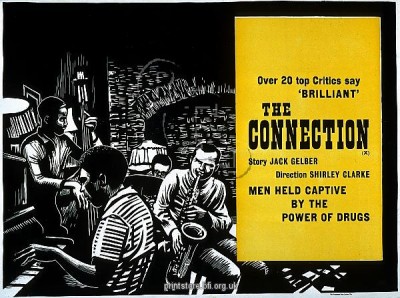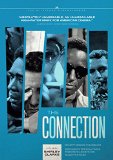| Reviews & Columns |
|
Reviews DVD TV on DVD Blu-ray 4K UHD International DVDs In Theaters Reviews by Studio Video Games Features Collector Series DVDs Easter Egg Database Interviews DVD Talk Radio Feature Articles Columns Anime Talk DVD Savant Horror DVDs The M.O.D. Squad Art House HD Talk Silent DVD
|
DVD Talk Forum |
|
|
| Resources |
|
DVD Price Search Customer Service #'s RCE Info Links |
|
Columns
|
|
|
Connection, The
The film premiered at the Cannes Film Festival in May 1961, but it was denied an exhibition license for its planned New York opening. Censors objected to the film's profanity, which is mostly limited to the use of the word "shit" to describe the heroin, though the overall subject matter (drug addiction) undoubtedly was also a factor. The filmmakers attempted to screen the film anyway, without a license, opening it at the D. W. Griffith Theater in New York on October 3, 1962, but after just two matinee performances that venue was shut down and, according to DVD Savant, the projectionist was arrested. It was rarely shown at all after that, and never recouped its small, $167,000 budget.
Happily, The Connection was preserved by the UCLA Film & Television Archive, with funding by the Film Foundation along with some private support (actor Jon Polito is among those thanked in these credits). Milestone's new Blu-ray offers a near-perfect presentation of the film along with many supplementary features.
In prologue narration, cameraman J.J. Burden (Browne) explains that he completed a film about junkies begun by a young (and white) aspiring filmmaker named Jim Dunn. William Redfield, whose dress and mannerisms suggest a young Peter Bogdanovich, plays Dunn. (Bogdanovich was certainly known among New York film circles during this time. Could he have been an inspiration for that look?) His fate, and the mystery as to why he didn't finish the picture himself, soon becomes obvious.
The entire story takes place in a run-down Greenwich Village loft belonging to junkie Leach (Warren Finnerty). Leach is in constant pain due to a large boil (or something) on his heavily bandaged neck. A dozen or so other addicts, mostly but not exclusively jazz musicians, hang around in various states of withdrawal. Most of these characters stay in the background, with Leach, jittering self-described musician Ernie (Garry Goodrow), and bald, hairy, and mustached Solly (Jerome Raphael) dominating.
Not much happens. Leach cuts up a pineapple (kept in a pot-bellied stove), offering slices to the dope fiends, few of which want to eat anything at all. Most everyone complains about one thing or another: Has their dealer run off with their money? Why is he so late? Jazz musicians Freddy (Freddie Redd), Jackie (Jackie McLean), and Larry (Larry Richie) play occasionally.
Dunn grows impatient, as the addicts don't seem to be doing or saying anything very interesting. "I know something of Eisenstein and Flaherty!" he declares, but they're unimpressed. Dunn is clearly a square trying to exploit a controversial subject. Increasingly bored and frustrated, the director toys with the idea of trying a fix himself. The dealer, superficially slick Cowboy (Carl Lee), finally shows up with a clueless elderly Salvation Army preacher, Sister Salvation (Barbara Winchester) acting as his cover. She thinks the men slipping into the bathroom one-by-one are sneaking glasses of wine.
The Connection is undeniably significant historically but dramatically dull. The set-up, with Dunn having paid the men for access to their den of iniquity only to be bushwhacked by their refusal to cooperate and provide him with swell confessional footage, turns the story into a Waiting for Godot-type exercise. Confining it to this single interior generates a claustrophobic feeling, but there's no dramatic tension. It plays like a filmed stage play, with Clarke favoring long takes shot from the very center of the room, her camera panning around in a circle from one character to another, with Burden's camera running out of film once in a while, necessitating swish-pan "cuts."
By 1961 standards, The Connection admittedly pushes the envelope with all the seedy and, for the time, shockingly dire atmosphere, but it's also as theatrical in appearance as much as it looks authentic. Other than the mild profanity and some barely-glimpsed adult magazines, there's very little that could not have been shown of TV's East Side/West Side (1963-64) just a few years later, or even a grittier Naked City episode from the period. Akira Kurosawa's similarly set-up The Lower Depths (1957) is a lot more involving, while his drug alley scenes in High and Low (1963), though heavily stylized, play more authentically.
The performers, most of whom look far too hearty to be completely convincing as strung-out addicts, are generally excellent. Other reviews have noted Finnerty's resemblance to Steve Buscemi, but to me he looks more like a young John Huston. Finnerty worked in movies and TV until a fatal heart attack cut short his career in 1974. After years on the stage and in live TV Redfield got big movies like Fantastic Voyage (1966) but likewise died early, of leukemia, shortly after co-starring in One Flew Over the Cuckoo's Nest (1975).
Video & Audio
The Connection was probably shot with at least 1.66:1 widescreen in mind, but here is presented 1.37:1 full-frame. There seems to be too much headroom above the actors, though other compositions seem to benefit from the 1.37:1 framing. The film elements sourced on this black-and-white production (original 35mm acetate and a 35mm composite master positive) are nearly perfect; only the end titles appear mildly warped. The audio is also exceptionally strong, with the jazz sequences mixed in at a higher level and extraordinarily clear and robust. Optional English subtitles are included.
Extra Features
Supplements include home movies taken on the set; a conversation with art director Albert Brenner; "Connecting with Freddie Redd"; a behind-the-scenes photo gallery; a trailer; and two 1964 marketing songs, apparently to help promote the film, "Who Killed Cocked Robin" and "I'm in Love." A 1959 radio interview listed on the packaging was withdrawn when the audio proved inadequate, though it's still accessible, such as it is, via Milestone's website.
Parting Thoughts
Of more interest because of its importance historically than dramatically but still a movie like no other, and because of terrific qualities of the Blu-ray and its extra features generally, The Connection is a DVD Talk Collector Series title.
Stuart Galbraith IV is the Kyoto-based film historian and publisher-editor of World Cinema Paradise. His credits include film history books, DVD and Blu-ray audio commentaries and special features.
|
| Popular Reviews |
| Sponsored Links |
|
|
| Sponsored Links |
|
|
| Release List | Reviews | Shop | Newsletter | Forum | DVD Giveaways | Blu-Ray | Advertise |
|
Copyright 2024 DVDTalk.com All Rights Reserved. Legal Info, Privacy Policy, Terms of Use,
Manage Preferences,
Your Privacy Choices | |||||||















